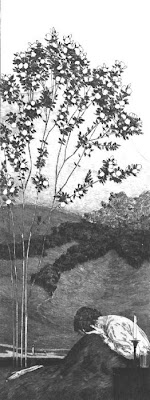 |
| Grunewald: The Temptation of St Anthony |
Dreams are a popular research topic for artists in all disciplines. Early explorations of the subject in visual form relate to Jacob's Ladder, and also the Temptation of St Anthony. The latter can be seen in the work of Grunewald right through to more recent artists such as Dali. These might be seen as more illustrational and less personal than say, Goya, with his 'The Dream of Reason Produces Monsters' in 1799, expressing the irrational nature of dreams as a contrast to the rational, at a time when scientists and philosophers were trying to constrain the irrational in the pursuit of reason. Goya was also battling his own demons, and particularly a physical illness that affected his hearing, and perhaps led to pressure in his head, and thus more dramatic dreams.
 |
| Goya: The Sleep of Reason Produces Monsters |
 |
| Yinka Shonibare: The Sleep of Reason Produces Monsters |
Some early psychologists explored the optical element within dreams. In the 19th century, Marquis d'Hervey de Saint Denis, (one of the first dream scientists), for example, created 'hypnagogic images' or coloured wheels of light and bubbles. The artists Miro, just into the 20th century, would press the flat bones around the base of his thumb into his eyes to create flashes, or spidery patterns of colour and light which then populated his paintings.
The most interesting, however, are the nineteenth century graphic artists who were well ahead of the scientists of their ages. Grandville demonstrated the visual transformations within dreams, and Klinger who eloquently showed the narrative quality and buried, or surpressed sexual symbolism within them. Redon captured the brooding atmosphere of dreams, and the sense of a separation of consciousness enmeshed with developments in science that were current at the time.
 |
| Grandville |
 |
| Grandville |

 |
| Klinger: The Glove Cycle |
Other artists who have used dreams include Gustave Courbet, who wanted to capture a face/his face at a moment of absolute terror. He engineered it so that he had a nightmare, and then woke up to see his terrified reflection in a mirror placed at the foot of his bed.
 |
| Courbet:The Desperate Man 1844 |
You might also look at any of the surrealists who built their entire movement on the importance of dreams and their meaning based on their reading of Freud's theory of development and psychoanalysis. Dali, de Chirico, and Max Ernst are good ones.
 |
| Dali: The Temptation of St Anthony |
Finally, you might be interested in looking at Erin Quinn's photographs of dreams, or Joshua Hoffine's photos of childhood nightmares.
 |
| Erin Quinn |
 |
| Joshua Hoffine |
















No comments:
Post a Comment